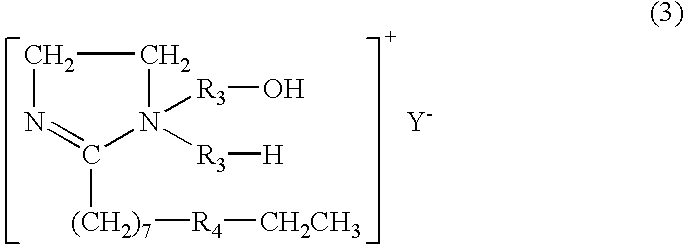Method of and composition for treating hydrocarbon based materials
a technology of hydrocarbon based materials and compositions, applied in detergent compositions, detergent compounding agents, liquid soaps, etc., can solve the problem of water-wet surface after treatment with compositions, and achieve the effect of low chemical oxygen demand and easy decomposition
- Summary
- Abstract
- Description
- Claims
- Application Information
AI Technical Summary
Benefits of technology
Problems solved by technology
Method used
Image
Examples
example 2
The additives listed in Tables 1-A and 1-C were examined to determine whether a film of water or whether a film of oil remained on a painted metal surface after first contacting the surface with the additive and then attempting to remove the additive from the surface. The surface was observed after removal of the additive. If beads of water were visible on the surface, then it was concluded that a film of oil was on the surface. If beads of water were not visible on the surface, then it was concluded that a film of water was on the surface.
The test results are shown in Table 2, below. The word "yes" indicates that a film of oil was present on the surface (beads of water were present). The word "no" indicates that a film of oil was not present on the surface (beads of water were not present) and, therefore, the surface was covered by a film of water.
The removal of the additive from the painted surface was attempted by three different techniques referred to as: (1) the dry wipe test; ...
example 5
A quantity of additive 20, as defined in Table 4-C above, can be placed in a hand applicator, such as a spray bottle, and applied directly on hydrocarbon components, such as oily sludges and hydrocarbon deposits, which adhere to a metal surface to remove the contaminants from the surface. In this regard,. additive 20 can be sprayed on the deposit, permitted to remain in contact with the deposit for a short time, such as a few minutes, and then the treated deposit can be contacted with hot or cold water to flush the deposit and any remaining additive from the surface. The removed deposits and additive form a water external emulsion which can be directed into a container where the emulsion is permitted to separate into an oil layer and a water layer. The oil layer can be recovered after it separates.
The recovered oil layer can be treated to produce an oil product, as is known in the art, and the water can be placed in normal waste-water facilities where it can treated, as is known in ...
example 6
Additive 20 can be used to remove thick, solid, adherent, hydrocarbon deposits, such as asphalt, from a surface. In this regard, additive 20 can be sprayed, poured, spread, or splashed on the deposit to form an accumulation of additive on the asphalt to a depth of about 1 / 8-inch. After a contact period of about 15 to 30 minutes, during which additive 20 is permitted to penetrate the asphalt, the deposit will soften sufficiently to enable its removal by mechanical action such as by scraping and / or shoveling.
Water can then be used to rinse or flush any remaining deposit and adherent oily film from the surface to thereby produce a cleaned water wet surface.
An aqueous emulsion can form during the rinse step in which case the phase separation, recovery, oil processing and disposal steps described in Example 5 can be employed.
This use of additive 20 obviates the prior art methods of chipping the deposit with a hammer and chisel or the repetitious application of prior art solvents to disso...
PUM
| Property | Measurement | Unit |
|---|---|---|
| ignition points | aaaaa | aaaaa |
| ignition points | aaaaa | aaaaa |
| ignition points | aaaaa | aaaaa |
Abstract
Description
Claims
Application Information
 Login to View More
Login to View More - R&D
- Intellectual Property
- Life Sciences
- Materials
- Tech Scout
- Unparalleled Data Quality
- Higher Quality Content
- 60% Fewer Hallucinations
Browse by: Latest US Patents, China's latest patents, Technical Efficacy Thesaurus, Application Domain, Technology Topic, Popular Technical Reports.
© 2025 PatSnap. All rights reserved.Legal|Privacy policy|Modern Slavery Act Transparency Statement|Sitemap|About US| Contact US: help@patsnap.com



